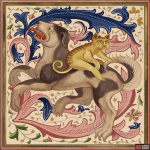Text
Throughout the Middle Ages, animals were viewed purely for their utility: this was no different for dogs and cats.
Although animals, according to the Church, had souls, these souls were mortal and could not attain salvation, unlike human souls. Thus, animals were considered inferior beings, subordinate to humans. (A groundbreaking perspective can be seen in the Ottoman law of 1502, which regulates the use of draught animals and is arguably the first law against animal cruelty. A similar law in Europe appeared only in 1822.)
The dog in this period served humans for hunting or guarding and could be trained. It is no wonder that, among other animals, dogs enjoyed certain privileges.
Breeding and crossbreeding of dogs did occur in the Middle Ages, but not nearly to the extent seen a few centuries later, when various domestic, miniature, or narrowly specialized breeds began to emerge. Most medieval breeds were focused solely on hunting and guarding and looked similar to Henry’s ![]() Mutt.
Mutt.
The cat, on the other hand, did what it wanted, and perhaps for this reason, it was viewed negatively as an embodiment of the devil and was not very popular (as evidenced by surviving illuminations, where it often appears more like a demonic creature).
Conversely, the situation was entirely different among Muslims. Christian travelers in Arab countries were amazed to find that cats were as beloved there as dogs were in Europe.


No Comments